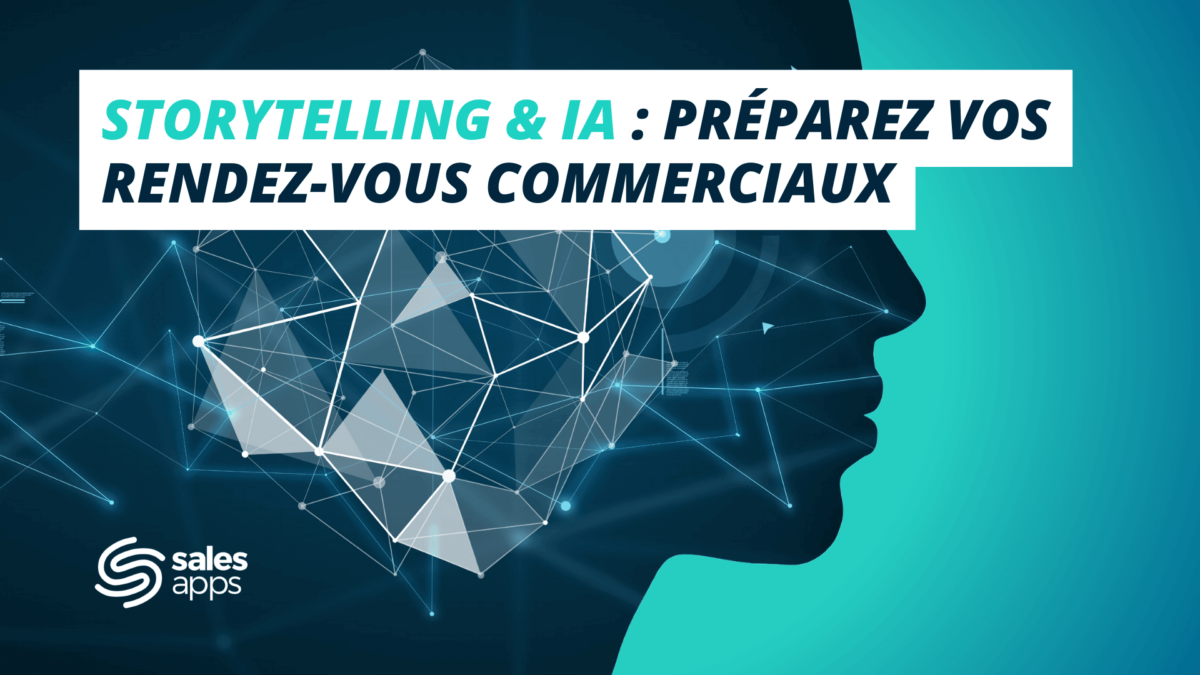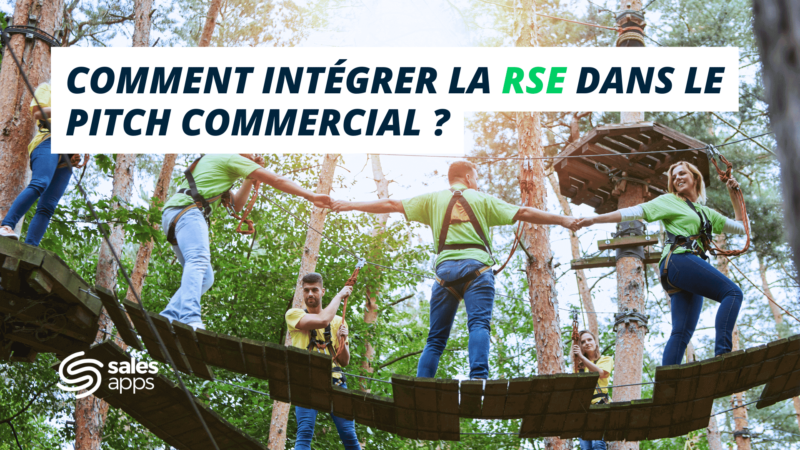
Blog

AI Storytelling sells! A study by the Stanford Graduate School of Business reveals that storytelling can increase conversion rates by up to 30%. But for storytelling to be truly impactful, it needs to be strategically prepared, with accurate data and a suitable narrative structure. That's where AI (Artificial Intelligence) and Modern Selling come in!
The foundations of good storytelling

Powerful storytelling can't be improvised; it requires careful preparation. When well conceived, it becomes a powerful asset for selling a product or service. But what are the key elements of good storytelling? It's essential to understand what sales people need to build an effective story, and what they actually have at their disposal. In B2B, data plays a fundamental role in this construction.
And yet, all too often, the data available is of poor quality. According to Gartner, 77% of companies consider the quality of data in their CRM to be poor or very poor. This is where Modern Selling and AI come into their own, offering effective resources for improving data quality and facilitating the creation of compelling narratives.
For b2b storytelling to be truly effective, it must be structured to be persuasive and in line with sales reps objectives. Storytelling doesn't just have to be captivating; it also has to serve a specific purpose: to sell a product or service. To achieve this, it's crucial to use data in a logical, pragmatic and personalized way, to support the sales argument and present information in a clear and convincing way for the buyer in an appointment.
Prepare your storytelling: all the keys at hand, even without AI

The information you gather about your buyer's needs and situation is invaluable in refining your storytelling. Whether it comes from your CRM following an appointment, a summary of your meeting or your own research on social networks, this information will enable you to personalize your story. Using this data, you'll be able to tailor your sales pitch and define a narrative structure for your presentation, helping to capture your caller's attention and make your message more memorable.
Preparation is all the more important as it will help you anticipate any objections the buyer may have during the meeting. The more you prepare your storytelling, the better you'll master it, giving you greater flexibility in your sales pitch. Situational intelligence, i.e. your ability to stay attuned to your buyer's signals, will enable you to maintain their interest throughout the exchange.
Marketing plays a key role in preparing your storytelling, as it is responsible for providing you with the content you need to support your pitch and make your presentation more engaging. Close collaboration between sales and marketing teams is therefore essential. Modern Selling is a major asset in this respect. Thanks to real-time alignment, you can maximize the impact of your storytelling and deliver a smoother, more consistent customer experience.
Modern Selling plays a central role in this agility. The application's sales paths allow you to contextualize and personalize your storytelling approach. As we'll see at the end of this article, your presentation can be adjusted live according to the progress of the meeting. This means you can pick up content on the fly to respond to a buyer's question or take your sales pitch a step further.
How can AI enrich your storytelling?

According to HubSpot (2023), 65% of sales reps say they use AI as part of their job. What are the main applications of AI in storytelling? How can AI contribute to effective storytelling?
1 - Pre-appointment customer briefing note
65% of sales reps say AI will help them better understand their customers (Hubspot). AI plays a key role in synthesizing information about a prospect and each of his or her interactions with your company, whether online or during exchanges with the sales reps. By analyzing data from a variety of sources, AI can generate a relevant summary of the buyer's situation. For example, it can compile past exchanges, expressed needs and powerful tools used, providing the sales rep with a clear and concise overview of the prospect's situation.
This summary not only saves the salesperson time in preparing for the meeting, but also enables him or her to better understand the buyer. As a result, he or she is able to prepare an appropriate and relevant storytelling, thus increasing the chances of a successful next meeting.
2 - Recommending the right next step
AI can also help the salesperson determine the right next step to take. By analyzing the buyer's behaviors and reactions during previous meetings, AI can recommend specific actions. For example, if AI detects a strong interest in a particular topic, it can suggest presenting a targeted narrative pathway during the next exchange, increasing the relevance of your storytelling. AI therefore has a role to play in personalizing the shopping experience.
This is what Hubspot underlines: 69% of sales professionals strongly or partly agree that AI can help them personalize the customer experience. AI can also help salespeople identify the right moment to follow up with the buyer, maximizing the effectiveness of their approach. This ability to recommend actions based on concrete data enables sales reps to optimize their follow-up strategy and engage the buyer in the best possible conditions.
3 - Post-appointment analysis
AI plays a key role in post-appointment analysis, making it possible to assess the effectiveness of the storytelling carried out. By collecting data on interactions, AI tools can provide valuable insights into what worked and what didn't. For example, they can identify which parts of the speech generated the most interest or, on the contrary, which were not effective. Thanks to these analyses, sales reps can adjust their approach for future appointments, strengthening their narrative impact and their ability to convert prospects into customers.
4 - Scripting the sales pitch
One of AI's most interesting contributions to storytelling is its ability to script the sales pitch based on data specific to the buyer/customer. Using the summary note of an appointment, the salesperson can prepare a pitch perfectly adapted to each prospect. The AI is able to deconstruct the information gathered during previous exchanges and create a coherent narrative structure based on the classic hero's journey (desire, obstacles and solution). This automated sales pitch scripting process boosts sales efficiency while deeply personalizing the sales pitch.
AI not only suggests a narrative structure based on the customer's profile, but also offers recommendations on the words and expressions to use, in order to optimize the emotional and rational impact of the message. In this way, the salesperson can focus on the human element and on interacting with the prospect, while having a clear roadmap for structuring his or her pitch, guided by the insights provided by AI. This approach reinforces the relevance of storytelling, making the sales pitch more fluid, focused and convincing.
5 - From storytelling to storydesign for your presentations
AI is a valuable asset for a marketing team! It can support them in analyzing appointments, training sales reps, or even creating sales content. When it comes to content production, AI has already proved its effectiveness in saving marketing teams a considerable amount of time. On average, it saves 3 hours and 10 minutes per piece of content created (Stratégie, 2023).
This time-saving doesn't come at the expense of quality: according to HubSpot, 89% of marketers who use generative AI see a clear improvement in the quality of their content. Good storytelling is only truly effective if it's accompanied by appropriate sales reps. Given that marketing benefits from both time savings and improved content quality, it would be a shame not to take advantage! There are many examples: infographics, interactive content (calculators or quizzes), case studies or even customer testimonials to enhance your storytelling during appointments.
AI can also suggest improvements to existing content based on the course of appointments, or recommend new content to be created to enrich the message. A marketing team can also benefit from conversational analysis of the appointment as a basis for improving the sales pitch.
Leverage Generative AI: prompts to enrich your storytelling and more

To guarantee the relevance of your prompts, we recommend that you provide as much context as possible (access to personas, sales force content, your value proposition, appointment type, USP, etc.) to your AI engine like ChatGPT, so that its responses matches your expectations.
1 - Generate a summary of the customer context
Prompt: "Synthesizes key CRM information about [Customer name], focusing on current priorities, goals and recently discussed challenges."
2 - Responding to a specific objection
Prompt: "Formulates a concise and convincing response to the objection: '[Customer objection]' highlighting how [Product/Service] specifically addresses this concern."
3 - Prepare a post-appointment summary
Prompt: "Write a summary of the meeting with [Customer's name] including points discussed, objections raised and next steps agreed. Formulate it in such a way that it can be shared as a follow-up to the exchange.
4 - Recommend content for follow-up
Prompt: "Suggest additional content tailored to [Customer name] to reinforce the message about [Value proposition] and maintain interest until the next appointment."
5 - Describe a before-and-after with our product/service
Prompt: "Tell a story showing [Customer name]'s situation before and after adopting [Product/Service]. Include specific details about the changes observed, emphasizing the concrete benefits and positive transformations achieved thanks to our solution."
6 - Develop a story around the customer's needs
Prompt: "Create a captivating storytelling starting from [Customer name]'s main challenges, illustrating how our solution precisely meets their needs in the [Industry] sector. Use anecdotes or concrete examples to make the story more relatable."
7 - Humanize the offer by telling a similar customer story
Prompt: "Write an inspiring story about a customer in the same industry as [Customer name] who used our solution to overcome a similar obstacle. Tell how this customer evolved thanks to our product, emphasizing the similarities with [Customer name]'s current challenges."
8 - Turning a frequent objection into a narrative opportunity
Prompt: "Create a story around the common objection: '[Customer objection]'. Show how customers in the same industry addressed this objection and ultimately found that [Product/Service] provided an effective response to their needs."
Modern Selling: accelerating your appointment storytelling

1 - Reinforce your storytelling by outlining the course of the meeting
With modern selling, you can optimize every customer meeting. One of the advantages of a modern selling application is its ability to automatically carry over everything that has been presented, enabling you to feed your preparation prompts precisely for the next appointment. Your application supports the salesperson's discourse by gradually introducing each key point of your pitch in a logical and fluid manner. This makes it easier for the buyer to understand the progression of your own stories, and to project themselves into the solution you're proposing.
Modern Selling doesn't just let each salesperson improvise his or her own storytelling; the application channels sales pitches around a "precise macro-storytelling", guaranteeing consistency and quality in the story told to each buyer. This "macro-storytelling" is conceived upstream by the marketing teams and/or sales management through the paths implemented in the Modern Selling application. It serves as a basic framework for initiating the story during the meeting, enabling each salesperson to start with a common, strategic message.
2 - Make it easier to remember your speech with an immersive visual narrative
Modern selling makes your storytelling more memorable, thanks to visual and interactive supports that make the narrative more immersive. The use of impactful elements - such as dynamic images, customer testimonial videos, illustrated case studies or 3D simulations - create a more vivid and engaging narrative. These elements boost retention by allowing the target audience to "see" and "experience" the story you're telling, beyond mere words. This visual immersion solidifies the key points of your pitch, while making the customer experience more captivating.
3 - Boost the impact of your storytelling in meetings
By enriching your sales approach with related complementary content, you increase buyer engagement and extend the reach of your storytelling. These additional media provide additional anchor points, facilitating deeper understanding and stronger buy-in. Another advantage of modern selling is the ability to adjust your storytelling in real time, bouncing off unexpected elements. This approach enables you to remain agile and reactive during the meeting: you adapt your sales pitch according to the buyer's spontaneous reactions and questions. This allows you to personalize your approach even further, demonstrating your active listening skills and your ability to respond precisely to their needs.
4 - Reinforce your storytelling with support materials
Modern Selling allows you to integrate concrete evidence into your sales pitch, such as customer testimonials, feedback, references and videos. These supports enrich your storytelling, adding credibility and substance. By presenting tangible evidence, you enable buyers to better project themselves into the solution you're proposing, into the story you're explaining, by showing how it has benefited others in similar contexts.
This makes your sales pitch more concrete, boosting buyer confidence and helping to speed up your sale. The integration of this content solidifies your argument, increasing the impact of your presentation, and therefore of your storytelling in the meeting.
Join Salesapps ENGAGE, to be informed of our upcoming events.
FAQ
Why is storytelling so important in sales and marketing?
Storytelling creates an emotional connection with the audience, making your message more memorable and captivating. Captivating stories help potential customers understand how your product or service meets their needs, increasing the chances of conversion. Visual storytelling also helps to improvebrand image in appointments.
How can AI improve storytelling?
AI makes it possible to analyze customer data and propose personalized content based on each prospect's preferences and behaviors. Thanks to this ability to adapt, the storytelling strategy becomes more targeted and relevant, improving the impact of each customer appointment.
What types of data are needed for AI to improve storytelling?
For AI to offer relevant suggestions, it's useful to provide data such as customer profiles, personas, information on past appointments, and audience reactions. The more complete the data, the more appropriate the recommendations.
How can AI help personalize the customer experience?
By analyzing past interactions and customer preferences, AI can recommend personalized actions, such as suggesting relevant content or indicating the best time for a reminder. This ability to adapt discourse in real time and personalize the customer journey enhances engagement and the overall experience, which is essential for building a relationship of trust and improving the sense of belonging.




